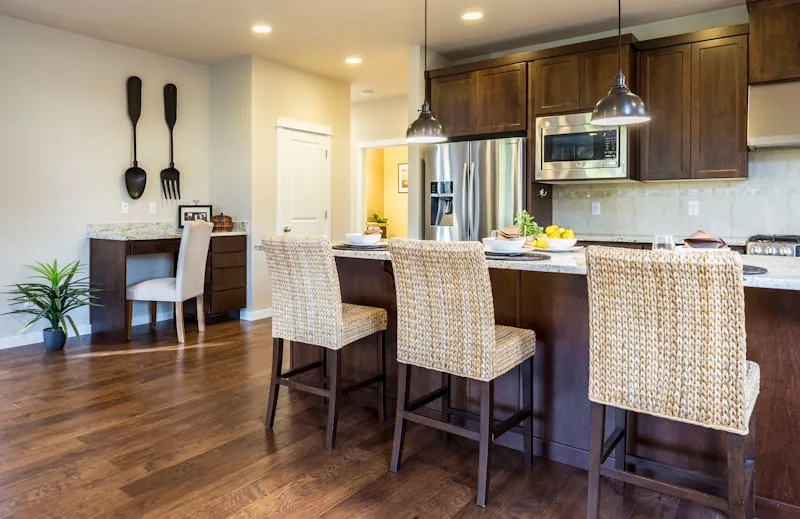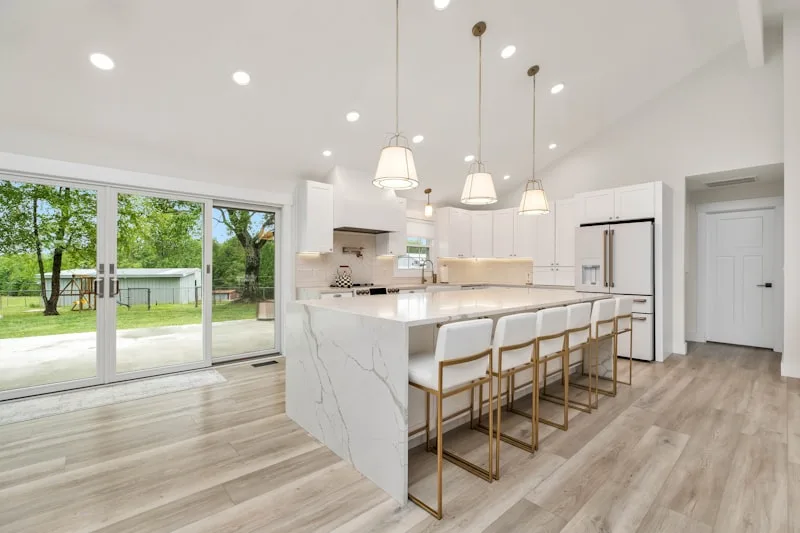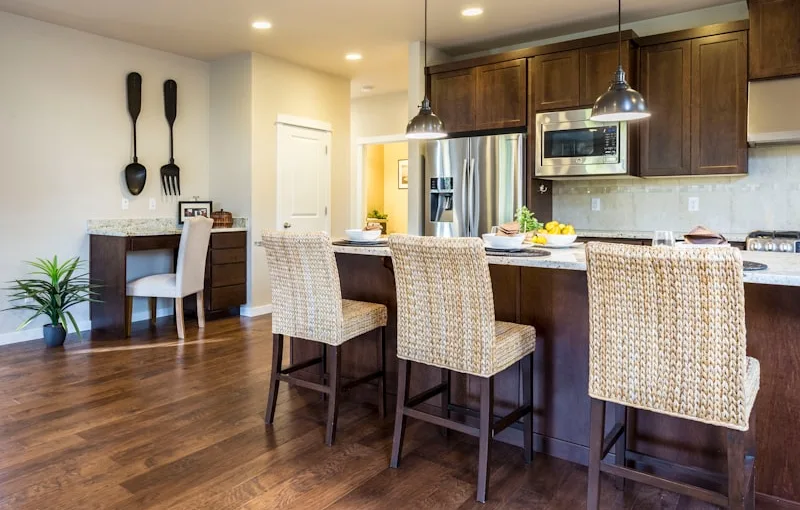So, why did your kitchen cabinet turn yellow over time? One of the main culprits is exposure to sunlight. Just like how your favorite white shirt can fade in the sun, your cabinets can also suffer from UV rays. If your kitchen gets a lot of natural light, those rays can break down the materials in your cabinets, leading to that unsightly yellow tint.
Another factor to consider is the type of finish on your cabinets. If they’re painted with oil-based paint, they’re more prone to yellowing compared to water-based options. It’s like choosing between a classic car and a modern one; the classic might look great but can come with its own set of issues. Additionally, cooking oils and grease can accumulate over time, creating a sticky residue that not only attracts dirt but can also contribute to discoloration. Think of it as a slow, sneaky villain that creeps in when you’re not looking!
Lastly, the age of your cabinets plays a role too. Just like us, materials can show signs of wear and tear as they age. If your cabinets are older, they might be more susceptible to yellowing due to the breakdown of the materials used in their construction. It’s a natural process, but it can be frustrating when you want your kitchen to look fresh and inviting.
The Mystery of Yellowing Cabinets: Unraveling the Causes Behind Your Kitchen’s Color Change
First off, let’s talk about the materials. If your cabinets are made of wood, they might be reacting to the natural oils and resins in the wood itself. Over time, exposure to light and air can cause these materials to oxidize, leading to that unwanted yellow tint. It’s like watching a beautiful sunset fade into the night—gradual but noticeable!
Then there’s the issue of smoke and grease. If you love cooking (and who doesn’t?), your kitchen might be a battleground of delicious aromas and, unfortunately, lingering grease. Cooking oils can settle on your cabinets, creating a film that not only attracts dirt but can also cause discoloration. Think of it as your cabinets wearing a greasy coat that they just can’t shake off.
And let’s not forget about the paint or finish. If your cabinets were painted with a low-quality product, they might not stand the test of time. Some paints can yellow due to UV exposure or simply age, much like how a white shirt can turn dingy after too many washes.
Lastly, humidity plays a role too. In a steamy kitchen, moisture can seep into the wood, causing it to warp and change color. It’s like your cabinets are trying to tell you they need a little TLC!
From Bright White to Dull Yellow: What’s Causing Your Kitchen Cabinets to Fade?
First off, let’s talk about the sun. Just like your skin can tan or burn, your cabinets can fade or discolor when exposed to UV rays. If your kitchen gets a lot of sunlight, those rays can break down the paint or finish, leading to that unsightly yellowing. It’s like your cabinets are trying to protect themselves from the sun, but instead, they end up looking worse for wear.
Then there’s the cooking factor. If you love whipping up delicious meals, the heat, steam, and grease from cooking can cling to your cabinets. Over time, this buildup can cause discoloration, making your cabinets look dingy. Think of it as a layer of grime that’s slowly dimming their shine. Regular cleaning can help, but sometimes it’s just not enough to combat the effects of daily cooking.
And let’s not forget about the quality of the materials used. Cheaper paints and finishes might look great initially, but they often lack the durability to withstand the test of time. It’s like buying a trendy shirt that fades after a few washes—disappointing, right? Investing in high-quality materials can make a world of difference in keeping your cabinets looking fresh and vibrant.
Is Your Kitchen Cabinetry Aging Prematurely? Discover the Surprising Reasons for Yellowing
First off, let’s talk about the materials. Many cabinets are made from wood or laminate, which can react to various environmental factors. Think of it like a sunbather getting too much sun—over time, exposure to light can cause the finish to break down, leading to that dreaded yellowing. If your kitchen gets a lot of sunlight, those rays might be more than just a warm welcome; they could be aging your cabinets faster than you’d like.
Then there’s the cooking factor. If you’re a culinary wizard who loves whipping up delicious meals, the steam, grease, and smoke from your stovetop can cling to your cabinets. It’s like a layer of grime that builds up over time, and guess what? That can contribute to discoloration. Imagine your cabinets wearing a greasy apron after a long day in the kitchen!
And let’s not forget about cleaning products. Some harsh chemicals can react with the finishes on your cabinets, leading to yellowing. It’s like using a strong detergent on a delicate fabric—it might clean, but it can also damage. So, if you’re using anything too abrasive, it might be time to rethink your cleaning routine.
So, before you start planning a complete kitchen overhaul, take a moment to consider these surprising culprits. Your cabinets might just need a little TLC to restore their former glory!
The Science of Yellowing: Why Your Kitchen Cabinets Are Losing Their Luster
First off, it’s essential to understand that yellowing is often a natural process. Over time, exposure to sunlight can cause materials like wood and paint to oxidize. Think of it like a sunbather getting a tan—too much sun can change the color! If your cabinets are made from a material that’s not UV-resistant, they’re more likely to take on that unwanted yellow hue.
But it’s not just sunlight at play. The kitchen is a bustling hub of activity, and with all that cooking, grease, and steam, your cabinets can take a beating. Imagine your cabinets as sponges soaking up all those cooking fumes. Over time, this buildup can lead to discoloration. It’s like a layer of grime that just won’t budge!
Another culprit? The type of finish on your cabinets. Some finishes are more prone to yellowing than others. If you’ve got a lacquer or oil-based paint, you might notice that they tend to yellow faster than water-based options. It’s like choosing between a quick snack and a hearty meal—one might satisfy you for a moment, but the other could leave you feeling sluggish in the long run.

So, what can you do to combat this yellowing? Regular cleaning and using the right products can help maintain that fresh look. Think of it as giving your cabinets a spa day! With a little TLC, you can keep them shining bright and looking as good as new.
Sunshine and Smoke: How Everyday Factors Are Turning Your Kitchen Cabinets Yellow
Let’s start with sunshine. We all love a sunlit kitchen, right? It’s warm, inviting, and perfect for those Instagram-worthy brunches. However, that glorious sunlight can be a double-edged sword. UV rays are relentless; they penetrate surfaces and break down the materials in your cabinets. Think of it like a slow-motion sunburn—over time, the finish on your cabinets can start to yellow, losing that fresh, clean look you adore.
Now, let’s talk about smoke. Whether it’s from cooking or the occasional candle, smoke can cling to surfaces like an unwelcome guest. It leaves behind a residue that not only dulls the finish but also contributes to that yellowing effect. Imagine your cabinets as a sponge, soaking up all those particles and turning from a bright white to a dingy yellow. Yikes!
And don’t forget about humidity! If you live in a humid area, the moisture in the air can exacerbate the problem, causing the materials in your cabinets to warp and discolor. It’s like a perfect storm brewing in your kitchen, and your cabinets are caught in the middle.
Cabinet Care 101: Tips to Prevent Your Kitchen from Turning Yellow Over Time
First off, let’s talk about the sun. Just like your skin, your cabinets can get sunburned too! Direct sunlight can cause that lovely white finish to fade and turn yellow. So, if your kitchen gets a lot of sun, consider using sheer curtains or blinds to filter those rays. Think of it as giving your cabinets a stylish sunhat!
Next up, let’s tackle the cleaning routine. You might be tempted to grab any old cleaner, but some products can be harsher than a bad breakup. Opt for gentle, pH-balanced cleaners that won’t strip away the finish. A simple mix of warm water and mild soap can work wonders. It’s like giving your cabinets a spa day!
And what about those pesky cooking fumes? If you’re frying up a storm, those oils can cling to your cabinets and contribute to that yellowing effect. Installing a good range hood can help whisk away those fumes before they settle in. Think of it as a superhero for your kitchen!
Lastly, consider the materials. If you’re planning a kitchen remodel, go for high-quality finishes that are less prone to discoloration. It’s like investing in a good pair of shoes; they’ll last longer and look better over time.
By following these tips, you can keep your kitchen cabinets looking as good as new, turning heads instead of yellowing with age!
Yellowing Cabinets: A Common Kitchen Dilemma and How to Combat It

Now, before you start thinking about a complete kitchen overhaul, let’s explore some practical solutions to combat this pesky problem. First off, a good cleaning can work wonders. Grab a gentle cleaner and a soft cloth, and give those cabinets a thorough wipe-down. You’d be surprised at how much grime can contribute to that yellow tint.
If cleaning doesn’t do the trick, consider a fresh coat of paint. It’s like giving your cabinets a rejuvenating spa day! Choose a high-quality, non-yellowing paint to ensure your cabinets stay bright and beautiful for years to come. And if you’re feeling adventurous, why not try a lighter shade? It can completely transform the space, making it feel airy and inviting.
Another tip? Keep your kitchen well-ventilated. Open those windows and let the fresh air in! This simple step can help reduce the heat and humidity that often lead to yellowing. Think of it as giving your cabinets a breath of fresh air.
So, whether you’re scrubbing, painting, or simply airing out your kitchen, tackling yellowing cabinets doesn’t have to be a daunting task. With a little effort, you can restore that fresh, clean look and enjoy your kitchen once again!
Frequently Asked Questions
Is Yellowing in Cabinets a Sign of Damage?
Yellowing in cabinets can indicate damage, often caused by exposure to sunlight, heat, or moisture. It may also result from aging materials or chemical reactions in finishes. Identifying the cause is essential for determining if repairs or replacements are necessary.
How Can I Prevent My Cabinets from Yellowing?
To prevent cabinets from yellowing, ensure they are made from high-quality materials and are properly finished. Regularly clean them with gentle, non-abrasive cleaners, and avoid exposure to direct sunlight by using window treatments. Additionally, maintain a consistent indoor temperature and humidity level to minimize discoloration.
What Causes Kitchen Cabinets to Turn Yellow?
Kitchen cabinets can turn yellow due to several factors, including exposure to sunlight, heat, and humidity. Over time, the finish on the cabinets can break down, leading to discoloration. Additionally, the use of certain cleaning products and the natural aging of materials can contribute to this yellowing effect. Regular maintenance and choosing high-quality finishes can help prevent this issue.
Can I Restore My Yellowed Cabinets to Their Original Color?
Yes, yellowed cabinets can often be restored to their original color using various cleaning methods and products. Start by cleaning the surfaces with a mixture of vinegar and water or a specialized wood cleaner. For deeper stains, consider using a wood bleach or refinishing product. Always test any solution on a small, inconspicuous area first to ensure it does not damage the finish.
What Types of Cabinets Are Most Prone to Yellowing?
Certain types of cabinets, particularly those made from low-quality materials or with a high gloss finish, are more susceptible to yellowing over time. Cabinets constructed from particleboard or MDF, especially when exposed to heat, moisture, or sunlight, can develop a yellow tint. Additionally, cabinets painted with oil-based paints are more likely to yellow compared to those finished with water-based paints. Regular maintenance and choosing high-quality materials can help mitigate this issue.
